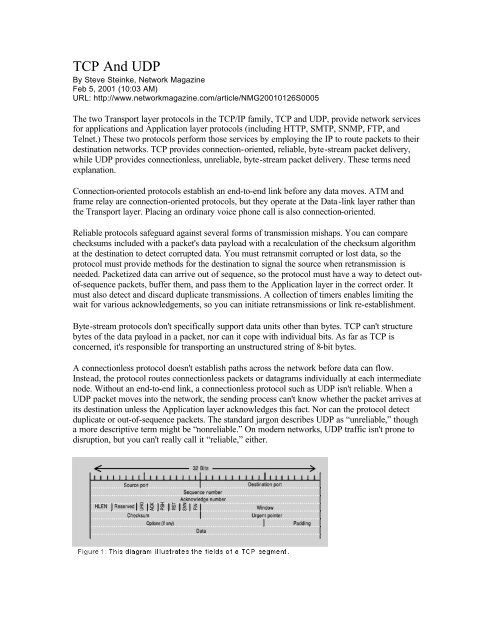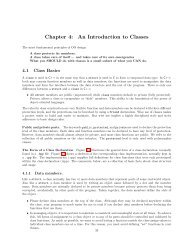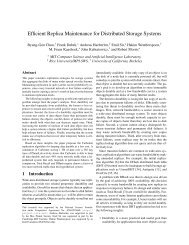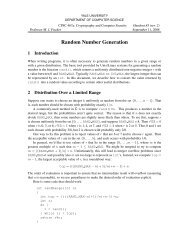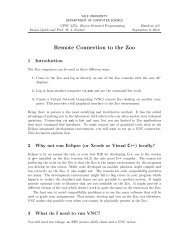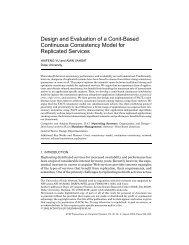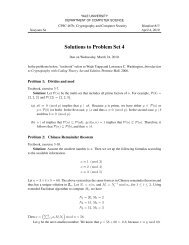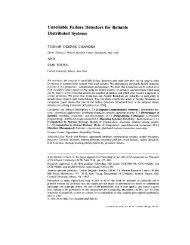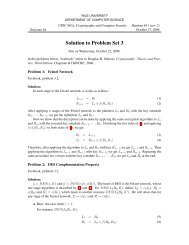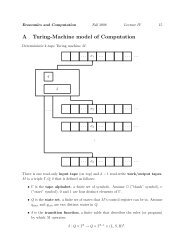TCP And UDP - Zoo
TCP And UDP - Zoo
TCP And UDP - Zoo
You also want an ePaper? Increase the reach of your titles
YUMPU automatically turns print PDFs into web optimized ePapers that Google loves.
<strong>TCP</strong> <strong>And</strong> <strong>UDP</strong>By Steve Steinke, Network MagazineFeb 5, 2001 (10:03 AM)URL: http://www.networkmagazine.com/article/NMG20010126S0005The two Transport layer protocols in the <strong>TCP</strong>/IP family, <strong>TCP</strong> and <strong>UDP</strong>, provide network servicesfor applications and Application layer protocols (including HTTP, SMTP, SNMP, FTP, andTelnet.) These two protocols perform those services by employing the IP to route packets to theirdestination networks. <strong>TCP</strong> provides connection-oriented, reliable, byte-stream packet delivery,while <strong>UDP</strong> provides connectionless, unreliable, byte-stream packet delivery. These terms needexplanation.Connection-oriented protocols establish an end-to-end link before any data moves. ATM andframe relay are connection-oriented protocols, but they operate at the Data -link layer rather thanthe Transport layer. Placing an ordinary voice phone call is also connection-oriented.Reliable protocols safeguard against several forms of transmission mishaps. You can comparechecksums included with a packet's data payload with a recalculation of the checksum algorithmat the destination to detect corrupted data. You must retransmit corrupted or lost data, so theprotocol must provide methods for the destination to signal the source when retransmission isneeded. Packetized data can arrive out of sequence, so the protocol must have a way to detect outof-sequencepackets, buffer them, and pass them to the Application layer in the correct order. Itmust also detect and discard duplicate transmissions. A collection of timers enables limiting thewait for various acknowledgements, so you can initiate retransmissions or link re-establishment.Byte-stream protocols don't specifically support data units other than bytes. <strong>TCP</strong> can't structurebytes of the data payload in a packet, nor can it cope with individual bits. As far as <strong>TCP</strong> isconcerned, it's responsible for transporting an unstructured string of 8-bit bytes.A connectionless protocol doesn't establish paths across the network before data can flow.Instead, the protocol routes connectionless packets or datagrams individually at each intermediatenode. Without an end-to-end link, a connectionless protocol such as <strong>UDP</strong> isn't reliable. When a<strong>UDP</strong> packet moves into the network, the sending process can't know whether the packet arrives atits destination unless the Application layer acknowledges this fact. Nor can the protocol detectduplicate or out-of-sequence packets. The standard jargon describes <strong>UDP</strong> as “unreliable,” thougha more descriptive term might be “nonreliable.” On modern networks, <strong>UDP</strong> traffic isn't prone todisruption, but you can't really call it “reliable,” either.
Figure 1 shows the fields of a <strong>TCP</strong> segment, the part of an IP packet that follows the IP headerinformation. The first 16 bits identify the source port, and the second 16 bits identify thedestination port. Port numbers provide a way for IP hosts to multiplex numerous types ofconcurrent connections at a single IP address. The combination of a 32-bit IP address and a 16-bitport address identifies a socket in most modern operating systems. The combination of a sourcesocket and a destination socket defines a <strong>TCP</strong> connection. There are 2 16 or 65,536 possible ports.The lowest 1,024 ports are called well-known ports; these are set aside by default for particularApplication layer protocols. For example, HTTP uses port 80 by default, while POP3 uses port110. Other applications can use the higher port numbers.The next two fields, the sequence number and the acknowledgement number, are the keys to<strong>TCP</strong>'s reliability functions. When a <strong>TCP</strong> connection is established, the initiating host sends anarbitrary initial sequence number to the initiatee. The initiatee adds 1 to the sequence number andreturns it to the initiator in the acknowledgement field, thereby indicating the next byte thatshould be sent. Once data begins to flow, the sequence and acknowledgement numbers keep trackof which data bytes have been sent and which data bytes have been acknowledged. Because eachfield is 32 bits, it can have 2 32 values, so each field ranges from 0 to 4,294,967,295 and wrapsaround to 0 when it passes the upper limit.The 4-bit data offset field simply indicates how many 32-bit words the <strong>TCP</strong> header has. Thisinformation is necessary because there are optional header fields, and the data offset marks wherethe header ends and the data begins.<strong>TCP</strong> designers set aside the next 6 bits, just in case they might be needed for future development.Since RFC793 (Transmission Control Protocol) dates to 1981, and no one since has established agood reason to use these reserved bits, Jon Postel and his colleagues must have been overlycautious.Each of the following 6 bits is a flag. An URG (urgent) flag with a value of 1 indicates that thedata in the urgent pointer field, farther along in the header, is significant. An ACK(acknowledgement) flag with a value of 1 indicates that the data in the acknowledgement numberfield is significant. (Note that an initial setup or SYN packet has a meaningful sequence number,but not a meaningful acknowledgement number, since it isn't acknowledging anything.) The PSH(push) flag prevents data from waiting to be sent and from waiting to be processed by thereceiving process. The RST (reset) flag shuts down a connection. The SYN (synchronization) flagindicates that the sequence number is significant. The FIN (finish) flag indicates the sender has nomore data to send.The Window field, 16 bits long, indicates the size of a so-called sliding window, which tells thesender how many bytes of data it's prepared to accept. <strong>TCP</strong> controls flow and congestion byadjusting the window size. A window equal to 0 tells a sender the receiver is overwhelmed andcan't accept anything more without further notice. Large window sizes enable as many as 65,536unacknowledged bytes to be in transit at any given time, but congestion—indicated when theretransmission timer expires without an acknowledgement—cuts the window size in half,effectively slowing the transmission rate.The 16-bit checksum field protects the data payload's integrity, the <strong>TCP</strong> header, and certain fieldsof the IP header. The sender calculates the checksum value and inserts it in this field, and thereceiver recalculates the value based on the received packet and compares the two. If they match,the data is probably intact.
The urgent pointer is a 16-bit offset value indicating the last byte that must be expedited when theurgent flag is set. The options field can hold 0 or more 32-bit words, extending <strong>TCP</strong>'s capabilities.The most commonly used option supports window sizes greater than 65,536 bytes, reducing thetime spent waiting for acknowledgements, especially at high data rates.<strong>TCP</strong> processing entities have multiple timers. The retransmission timer begins when a segment issent and stops when the acknowledgement is received. If it times out without anacknowledgement, the segment is sent again. One tricky problem is setting the value for thetimeout period. If it's too long, unnecessary waiting occurs when the network drops or garblesnumerous segments. If it's too short, the network will have too many duplicate segments whenresponse slows down. Modern <strong>TCP</strong> implementations set the retransmission timer valuedynamically in response to conditions.The persistence timer is necessary to prevent a particular deadlock condition. If the networkreceives a 0-size window acknowledgement and loses the subsequent acknowledgement thatrestarts the flow, the persistence timer expires and sends a probe. The response indicates thewindow size (which may still be zero, in which case the timer starts over.)The keepalive timer checks whether there is still an active process at the other end of theconnection after no activity. The timer shuts down the connection if no response occurs.A closing connection timer also provides for a period of twice the maximum packet lifetime whena connection is shut down. This timer makes sure the traffic is flushed through the connectionbefore it's closed.No matter how efficiently the retransmission process is implemented, however, a small number ofdropped packets can seriously undermine the throughput of a <strong>TCP</strong> connection. Each packet, orfragment of a packet, that isn't received will only be missed when the retransmission timerexpires. The receiving process must deliver the byte stream in order, so retransmission stops theflow of data until the missing bytes can be replaced. These retransmissions account for thesometimes herky-jerky performance of <strong>TCP</strong>-based links.If you compare a <strong>UDP</strong> segment's structure (see Figure 2) to that of <strong>TCP</strong>, it's apparent that <strong>UDP</strong>doesn't have <strong>TCP</strong>'s complex reliability and control mechanisms. <strong>UDP</strong>'s source and destinationport numbers support multiplexed applications on a host, just as <strong>TCP</strong>'s do. The content of a 16-bit<strong>UDP</strong> length field is equal to the length of the 8-byte header plus the length of data, while thechecksum field enables integrity checking. (Many applications commonly employing <strong>UDP</strong>, suchas streaming media, derive no added value from data integrity, and wouldn't retransmit corruptedpackets even if they identified them.)<strong>TCP</strong> is clearly the protocol of choice for data transactions where performance must give way tointegrity, controllability, and reliability. <strong>UDP</strong> is the best choice when performance matters morethan perfect data integrity, as in voice and multimedia applications. <strong>UDP</strong> is also a good choice for
transactions so short that connection setup overhead is a large fraction of total traffic, forexample, in DNS exchanges. The decision to base SNMP on <strong>UDP</strong> was made partly becausedesigners thought that <strong>UDP</strong> would have a better chance of delivering management data whennetworks were distressed or congested because of <strong>UDP</strong>'s lower overhead. <strong>TCP</strong>'s rich functionalitysometimes results in unpredictable performance, but reliable end-to-end connections are likely tosupport most networked applications for the foreseeable future.Steve Steinke, editor in chief, can be reached at ssteinke@cmp.com.ResourcesThe horse's mouth for <strong>TCP</strong> is RFC793, which dates to 1981. Among the many Internet RFCrepositories is www.freesoft.org/CIE/index.htm. This Internet Encyclopedia site also includesfurther descriptions of <strong>TCP</strong> operation.The preeminent discussions of <strong>TCP</strong> for application developers and others needingimplementation details can be found in:<strong>TCP</strong>/IP Illustrated, Volume 1: The Protocols by W. Richard Stevens (1994, Addison Wesley,ISBN: 0201633469)<strong>TCP</strong>/IP Illustrated, Volume 2: The Implementation by Gary R. Wright and W. Richard Stevens(1995, Addison Wesley, ISBN: 020163354X)Internetworking with <strong>TCP</strong>/IP Vol. I: Principles, Protocols, and Architecture by Douglas E. Comer(1995, Prentice Hall, ISBN: 0132169878)Internetworking with <strong>TCP</strong>/IP, Vol.II, ANSI C Version, Design, Implementation, and Internals byDouglas E. Comer, David L. Stevens (1998, Prentice Hall, ISBN: 0139738436)


